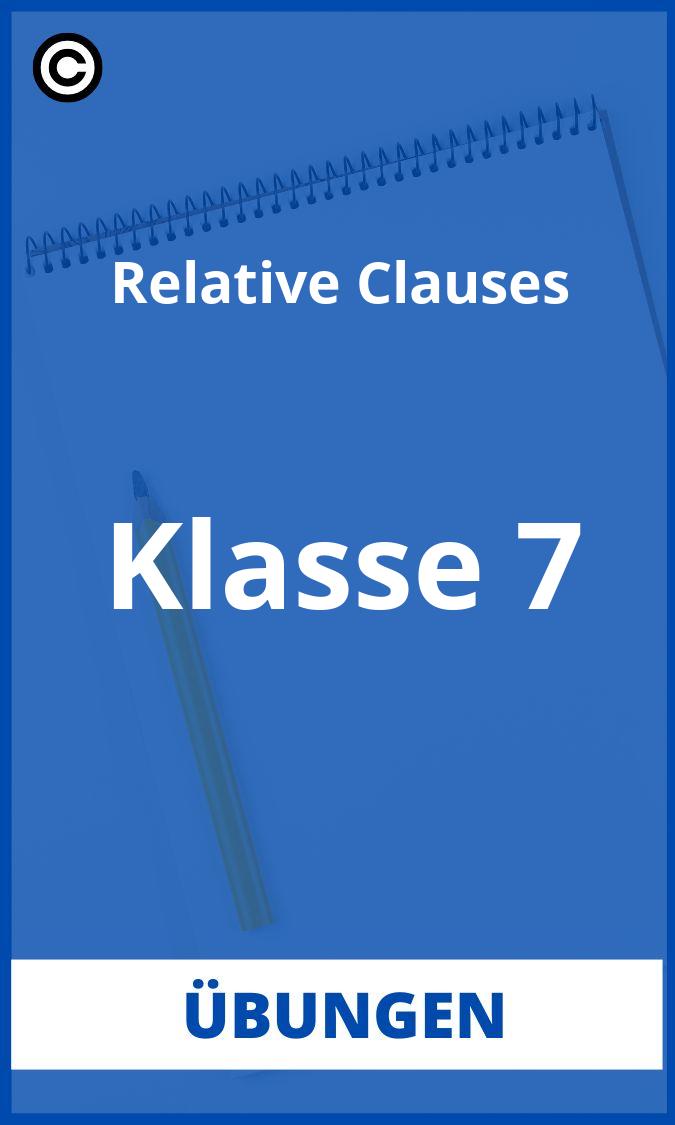
Relative Clauses Übungen Klasse 7 Mit Lösungen PDF
Relative Clauses Klasse 7 Übungen – Öffnen PDF
Dies ist ein Artikel über die „Relative Clauses Übungen Klasse 7“.
Es gibt verschiedene Arten von Relativsätzen, und sie können in verschiedenen Kontexten verwendet werden. Die Klasse 7 ist eine gute Gelegenheit, um mehr über diese Sätze zu lernen.
Relative clauses sind ein wichtiger Bestandteil der englischen Sprache, und sie können in vielen verschiedenen Kontexten verwendet werden. In der Klasse 7 werden wir uns mit den verschiedenen Arten von Relativsätzen befassen und herausfinden, wie wir sie in unseren eigenen Sätzen verwenden können.
Was sind Relativsätze?
Relative clauses sind Sätze, die Informationen über ein bestimmtes Subjekt enthalten. In den meisten Fällen wird ein Relativsatz verwendet, um mehr Informationen über ein bestimmtes Subjekt zu geben. Zum Beispiel:
The man who lives next door is very friendly.
In diesem Satz wird der Relativsatz „who lives next door“ verwendet, um mehr Informationen über das Subjekt „the man“ zu geben. In diesem Fall sagt uns der Relativsatz, dass der Mann, von dem wir sprechen, nebenan wohnt.
Relative clauses können auch verwendet werden, um bestimmte Informationen auszuschließen. Zum Beispiel:
I don’t like the color of my car.
In diesem Satz wird der Relativsatz „of my car“ verwendet, um auszuschließen, dass ich das Auto mag. Wir wissen also, dass ich das Auto nicht mag, weil ich nicht mag, wie es aussieht.
Relative clauses können auch verwendet werden, um bestimmte Informationen hervorzuheben. Zum Beispiel:
I saw the movie that you told me about.
In diesem Satz wird der Relativsatz „that you told me about“ verwendet, um hervorzuheben, welchen Film ich gesehen habe. Wir wissen also, dass ich den Film gesehen habe, weil du mir davon erzählt hast.
Relative clauses können auch verwendet werden, um bestimmte Informationen zu erklären. Zum Beispiel:
I put the book that I was reading on the table.
In diesem Satz wird der Relativsatz „that I was reading“ verwendet, um zu erklären, welches Buch ich auf den Tisch gelegt habe. Wir wissen also, dass ich das Buch auf den Tisch gelegt habe, weil ich es gelesen habe.
Wie verwende ich Relativsätze?
Relative clauses werden häufig in Sätzen verwendet, in denen ein bestimmtes Subjekt vorkommt. Zum Beispiel:
The man who lives next door is very friendly.
In diesem Satz wird der Relativsatz „who lives next door“ verwendet, um mehr Informationen über das Subjekt „the man“ zu geben. In diesem Fall sagt uns der Relativsatz, dass der Mann, von dem wir sprechen, nebenan wohnt.
Relative clauses können auch in Sätzen verwendet werden, in denen kein bestimmtes Subjekt vorkommt. Zum Beispiel:
I don’t like the color of my car.
In diesem Satz wird der Relativsatz „of my car“ verwendet, um auszuschließen, dass ich das Auto mag. Wir wissen also, dass ich das Auto nicht mag, weil ich nicht mag, wie es aussieht.
Relative clauses können auch in Sätzen verwendet werden, in denen bestimmte Informationen hervorgehoben werden sollen. Zum Beispiel:
I saw the movie that you told me about.
In diesem Satz wird der Relativsatz „that you told me about“ verwendet, um hervorzuheben, welchen Film ich gesehen habe. Wir wissen also, dass ich den Film gesehen habe, weil du mir davon erzählt hast.
Relative clauses können auch in Sätzen verwendet werden, in denen bestimmte Informationen erklärt werden sollen. Zum Beispiel:
I put the book that I was reading on the table.
In diesem Satz wird der Relativsatz „that I was reading“ verwendet, um zu erklären, welches Buch ich auf den Tisch gelegt habe. Wir wissen also, dass ich das Buch auf den Tisch gelegt habe, weil ich es gelesen habe.
Was sind relative clauses Beispiele?
Relative clauses are clauses that are used to modify a noun. They are typically introduced by a relative pronoun, such as „who“ or „that.“ Relative clauses can be used to provide additional information about a noun, or to specify which noun is being referred to. For example, the sentence „The woman who lives next door is my mother“ contains a relative clause that provides additional information about the woman. The relative clause can also be used to specify which woman is being referred to, as in the sentence „The woman that I saw yesterday is my mother.“
Relative clauses are often used in situations where it is necessary to provide additional information about a noun in order to make the sentence clear. For example, consider the following sentence: „I saw a woman on the bus.“ This sentence is perfectly clear without any additional information. However, if the sentence is changed to „I saw the woman who was sitting in front of me on the bus,“ the relative clause provides additional information that helps to clarify which woman is being referred to. In this case, the relative clause is necessary in order to avoid ambiguity.
It is also possible to use relative clauses to provide additional information about a noun that is not essential to the meaning of the sentence. For example, the sentence „The poet that I admire most is Langston Hughes“ contains a relative clause that provides non-essential information about the poet. The relative clause does not change the basic meaning of the sentence, which is that the speaker admires Langston Hughes. However, the relative clause does add some additional information that might be of interest to the reader.
Wie bildet man die relative clauses?
Wie bildet man relative clauses?
Relative clauses sind Sätze, die ein Noun identifizieren oder näher erläutern. Sie werden häufig in englischen Sätzen verwendet und können sehr nützlich sein, um einen Satz kürzer und prägnanter zu gestalten. Die Bildung von relative clauses ist relativ einfach und es gibt nur einige wenige Regeln, die man beachten muss.
Zunächst einmal muss man sich überlegen, welches Noun die relative clause identifizieren oder näher erläutern soll. Dieses Noun wird dann in die relative clause eingefügt und durch ein Pronomen ersetzt. Die häufigsten Pronomen, die in relative clauses verwendet werden, sind ‚that‘, ‚which‘, ‚who‘ und ‚whom‘. Welches Pronomen man verwendet, hängt von der Funktion des Nouns in der relative clause ab.
Wenn das Noun ein Objekt ist, sollte man ‚that‘ oder ‚which‘ verwenden. Wenn das Noun ein Subjekt ist, sollte man ‚who‘ oder ‚whom‘ verwenden. Beachten Sie, dass ‚who‘ und ‚whom‘ auch für Objekte verwendet werden können, aber ‚that‘ und ‚which‘ nicht für Subjekte verwendet werden können.
Zum Beispiel:
- The man who I saw yesterday is my friend. (Subjekt)
- The man whom I saw yesterday is my friend. (Objekt)
- The book that I read last week was interesting. (Objekt)
- The book which I read last week was interesting. (Objekt)
Beachten Sie, dass in einigen Fällen das Pronomen weggelassen werden kann, wenn es sich um ein Objekt handelt. Dies ist jedoch nur der Fall, wenn das Objekt bereits im Satz vorkommt und klar ist, welches Objekt gemeint ist. Zum Beispiel:
- The man who I saw yesterday is my friend. (Subjekt)
- The man whom I saw yesterday is my friend. (Objekt)
- The book that I read last week was interesting. (Objekt)
- The book which I read last week was interesting. (Objekt)
Wenn das Noun ein Possessiv ist, muss man das Possessiv-s weglassen. Zum Beispiel:
- The man whose car was stolen is my friend. (Possessiv)
- The book whose author is unknown is interesting. (Possessiv)
Beachten Sie auch, dass, wenn das Noun ein Possessiv ist, das Pronomen ‚whose‘ nur für Subjekte verwendet werden kann. Wenn das Noun ein Objekt ist, muss man ‚of which‘ verwenden. Zum Beispiel:
- The man whose car was stolen is my friend. (Possessiv)
- The man of whom I saw the car yesterday is my friend. (Objekt)
- The book whose author is unknown is interesting. (Possessiv)
- The book of which I read the first chapter is interesting. (Objekt)
Beachten Sie, dass in einigen Fällen das Possessiv-s weggelassen werden kann, wenn es sich um ein Objekt handelt. Dies ist jedoch nur der Fall, wenn das Objekt bereits im Satz vorkommt und klar ist, welches Objekt gemeint ist. Zum Beispiel:
- The man whose car was stolen is my friend. (Possessiv)
- The man of whom I saw the car yesterday is my friend. (Objekt)
- The book whose author is unknown is interesting. (Possessiv)
- The book of which I read the first chapter is interesting. (Objekt)
Beachten Sie, dass das Pronomen ‚that‘ auch für Possessive verwendet werden kann, aber dies ist nicht sehr häufig der Fall. Zum Beispiel:
- The car that I saw yesterday is my friend’s. (Possessiv)
Die relative clause kann am Anfang, in der Mitte oder am Ende des Satzes stehen. Die Wahl des Platzes hängt von der Bedeutung ab, die man damit vermitteln möchte. Wenn die relative clause ein Objekt identifiziert, sollte sie am Ende des Satzes stehen. Wenn sie ein Subjekt identifiziert, kann sie am Anfang oder in der Mitte des Satzes stehen. Zum Beispiel:
- The man who I saw yesterday is my friend. (Subjekt)
- The man who is my friend I saw yesterday. (Subjekt)
- The man I saw yesterday is my friend. (Subjekt)
- The car that I saw yesterday is my friend’s. (Objekt)
Beachten Sie, dass, wenn die relative clause am Anfang des Satzes steht, das Pronomen ‚that‘ weggelassen werden kann. Zum Beispiel:
- The man who I saw yesterday is my friend. (Subjekt)
- The man who is my friend I saw yesterday. (Subjekt)
- The man I saw yesterday is my friend. (Subjekt)
- The car that I saw yesterday is my friend’s. (Objekt)
Die relative clause kann auch am Anfang des Satzes stehen, wenn das Objekt bereits im Satz vorkommt. In diesem Fall wird das Pronomen ‚that‘ weggelassen. Zum Beispiel:
- The man that I saw yesterday is my friend. (Objekt)
- The car that I saw yesterday is my friend’s. (Objekt)
Beachten Sie,
Wie erkennt man relative clauses?
Wie erkennt man relative clauses?
Relative clauses sind ein wesentlicher Bestandteil der englischen Sprache und können einige Zeit in Anspruch nehmen, bis man sie beherrscht. Doch keine Sorge, mit etwas Übung kann man sie bald ganz einfach erkennen und verwenden. In diesem Artikel werden wir uns mit den Grundlagen der relative clauses befassen und sehen, wie man sie in einem Satz erkennt.
Zunächst einmal ist es wichtig zu wissen, was ein relative clause ist. Ein relative clause ist ein Nebensatz, der Informationen über ein anderes Wort im Hauptsatz liefert. In der Regel wird ein relative clause mit einem bestimmten Wort eingeleitet, das als relative pronoun bezeichnet wird. Die häufigsten relative pronouns sind who, whom, whose, that, which und where.
Relative clauses können den Leser oder Zuhörer über eine Person, eine Sache, einen Ort oder eine Zeit informieren. Sie können auch ein Attribut oder ein Adjektiv sein. Einige Beispiele für relative clauses sind:
- The man who is standing over there is my brother. (Der Mann, der dort steht, ist mein Bruder.)
- The book that you are reading is very interesting. (Das Buch, das du gerade liest, ist sehr interessant.)
- The house which we bought last year is very nice. (Das Haus, das wir letztes Jahr gekauft haben, ist sehr schön.)
- The city where I was born is very beautiful. (Die Stadt, in der ich geboren wurde, ist sehr schön.)
As you can see from the examples above, a relative clause can be used to provide information about a person, a thing, a place or a time. They can also be used to describe an attribute or an adjective.
Now that we know what a relative clause is, let’s take a look at how to identify one in a sentence. As we mentioned before, a relative clause is usually introduced by a relative pronoun. This relative pronoun will usually come at the beginning of the relative clause. However, there are some cases where the relative pronoun can come at the end of the relative clause. We will look at these cases later on in the article.
The relative pronoun will usually be followed by a verb. In some cases, the verb can be omitted. We will also look at these cases later on.
So, to summarise, a relative clause can be identified by the following structure:
- Relative pronoun + verb
- Relative pronoun + verb + noun
Now let’s take a look at some examples of relative clauses in sentences.
- The man who is standing over there is my brother.
- The book that you are reading is very interesting.
- The house which we bought last year is very nice.
- The city where I was born is very beautiful.
As you can see, each of the sentences above has a relative clause. The relative clause is introduced by a relative pronoun and is followed by a verb. In some cases, the relative pronoun can be omitted. We will look at these cases later on in the article.
Now let’s take a look at some more examples of relative clauses. In these examples, the relative pronoun is followed by a verb and a noun.
- I have a friend who lives in London.
- I have a friend who lives in London.
- The woman whose car was stolen is very upset.
- The conference which took place last week was very successful.
As you can see, the relative pronoun is followed by a verb and a noun in each of the sentences above.
Now let’s take a look at some cases where the relative pronoun can be omitted. In these cases, the relative pronoun is implied and does not need to be explicitly stated.
- I have a friend who lives in London.
- The conference which took place last week was very successful.
As you can see, the relative pronoun is implied in each of the sentences above but is not explicitly stated.
Now let’s take a look at some cases where the relative pronoun can come at the end of the relative clause. In these cases, the relative pronoun is usually introduced by the word „that“.
- This is the book that I was telling you about.
- I didn’t realise that you were coming.
As you can see, the relative pronoun is introduced by the word „that“ in each of the sentences above.
Now let’s take a look at some cases where the verb can be omitted. In these cases, the verb is usually implied and does not need to be explicitly stated.
- I have a friend who lives in London.
- The conference which took place last week was very successful.
As you can see, the verb is implied in each of the sentences above but is not explicitly stated.
So, to summarise, a relative clause can be identified by the following structure:
- Relative pronoun + verb
- Relative pronoun + verb + noun
Now that we know how to identify a relative clause, let’s take a look at how to use them.
Relative clauses can be used to provide information about a person, a thing, a place or a time. They can also be used to describe an attribute or an adjective.
Here are some examples of how relative clauses can be used:
- The man who is standing over there is my brother.
- The book that you are reading is very interesting.
- The house which we bought last year is very nice.
- The city where I was born is very beautiful.
As you can see, relative clauses can be used to provide information about a person, a thing, a place or a time. They can also be used to describe an attribute or an adjective.
Now that we know how to identify and use relative clauses, let’s take a look at some practice exercises.
Complete the following sentences with the correct relative pronoun.
- The man ___________ is standing over there is my brother.
- The
Was für relative clauses gibt es?
Es gibt drei Haupttypen von relativen Klauseln in Deutsch:
Nominativklauseln werden verwendet, wenn die betreffende Person oder Sache im Nominativ (Einzahl oder Maskulin) steht. Einige Beispiele für Nominativklauseln sind:
- Der Mann, der auf der Straße steht, ist mein Cousin.
- Das Haus, in dem ich wohne, ist sehr alt.
- Ich habe den Hund, den du mir gestern gegeben hast, eingeschläfert.
Akkusativklauseln werden verwendet, wenn die betreffende Person oder Sache im Akkusativ (Einzahl oder Maskulin) steht. Einige Beispiele für Akkusativklauseln sind:
- Ich habe den Mann, den du mir gestern gezeigt hast, heute wiedergetroffen.
- Das ist das Haus, in dem wir wohnen werden.
- Ich habe den Hund, den du mir gestern gegeben hast, eingeschläfert.
Dativklauseln werden verwendet, wenn die betreffende Person oder Sache im Dativ (Einzahl oder Maskulin) steht. Einige Beispiele für Dativklauseln sind:
- Der Mann, dem ich die Tür geöffnet habe, ist mein Cousin.
- Das ist das Haus, in dem wir wohnen werden.
- Ich habe den Hund, den du mir gestern gegeben hast, eingeschläfert.
Es gibt viele Arten von relatives Klauseln, aber sie alle haben eines gemeinsam: sie funktionieren, indem sie ein bestimmtes Nomen identifizieren. Dies kann durch ein bestimmtes Wort (wie „der“, „die“ oder „das“) oder durch ein Possessivpronomen (wie „mein“, „dein“ oder „sein“) erfolgen. In einigen Fällen kann das Nomen auch durch ein Demonstrativpronomen identifiziert werden (wie „dieser“, „jener“ oder „derjenige“).
Einige Arten von relatives Klauseln sind:
- Defining relative clauses – dies sind die häufigsten Arten von relatives Klauseln, die verwendet werden, um ein Nomen eindeutig zu identifizieren. Beispielsweise: Der Mann, den ich traf, war sehr nett. In diesem Fall identifiziert die relative Klausel („der Mann, den ich traf“) das Nomen („Mann“).
- Non-defining relative clauses – diese Art von relative Klausel wird verwendet, um zusätzliche Informationen über ein Nomen zu liefern, aber sie ist nicht erforderlich, um das Nomen eindeutig zu identifizieren. Beispielsweise: Mein Vater, der Lehrer ist, unterrichtet Englisch. In diesem Fall gibt die relative Klausel („die Lehrer ist“) zusätzliche Informationen über das Nomen („Vater“) an, aber sie ist nicht erforderlich, um das Nomen eindeutig zu identifizieren.
- Reduced relative clauses – dies sind relative Klauseln, die aufgrund ihrer Länge oder Komplexität gekürzt werden. Beispielsweise: Der Mann, den ich getroffen habe, war sehr nett. In diesem Fall ist die relative Klausel („der Mann, den ich getroffen habe“) gekürzt und liefert nicht so viele Informationen wie die vollständige relative Klausel („der Mann, den ich getroffen habe, war sehr nett“).
- Relative clauses with prepositions – dies sind relative Klauseln, die eine Präposition enthalten, um das Nomen zu identifizieren. Beispielsweise: Der Ort, an dem ich wohne, ist sehr schön. In diesem Fall identifiziert die relative Klausel („der Ort, an dem ich wohne“) das Nomen („Ort“) mit Hilfe der Präposition „an“.
Relatives Klauseln sind ein wichtiger Bestandteil der englischen Grammatik und sie können in vielen verschiedenen Arten verwendet werden. Durch das Üben von relatives Klauseln wird sichergestellt, dass du sie richtig verwendest und so deine kommunikativen Fähigkeiten verbesserst.






